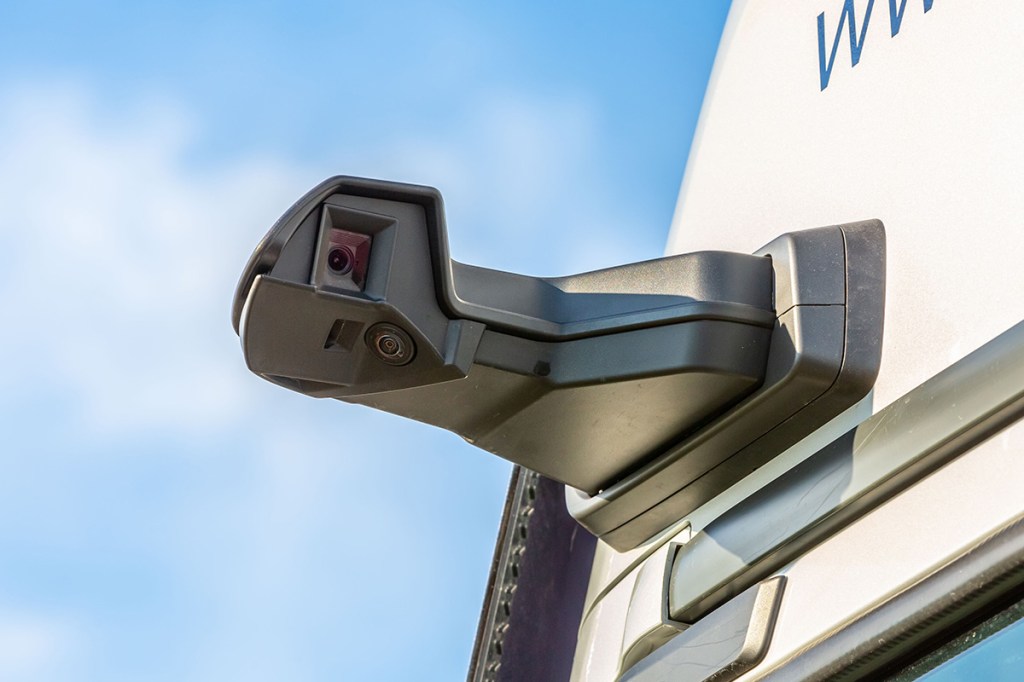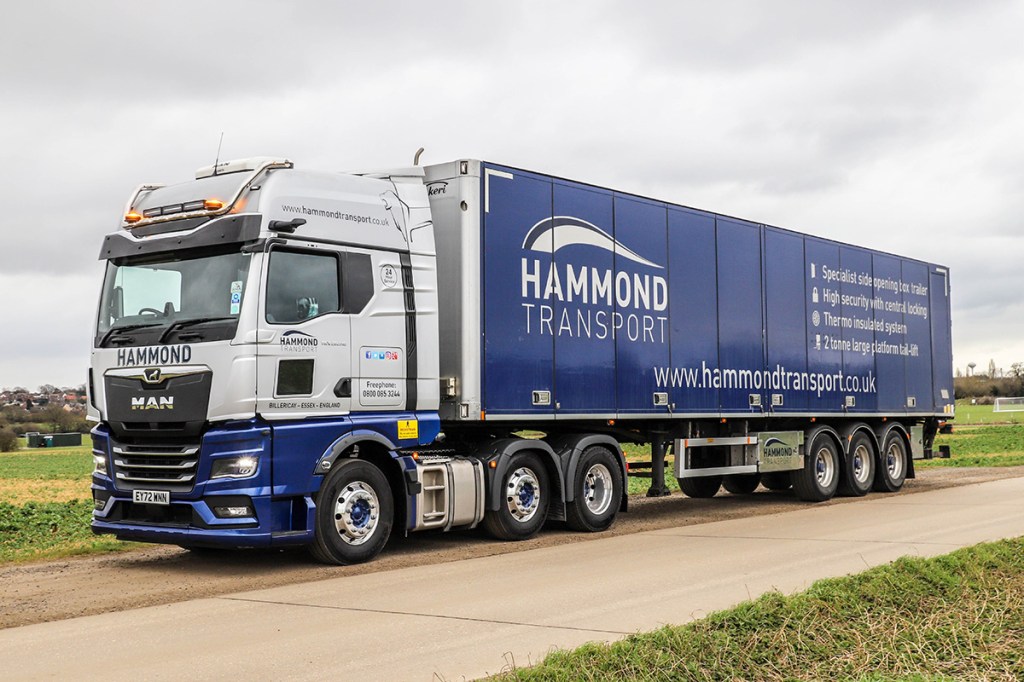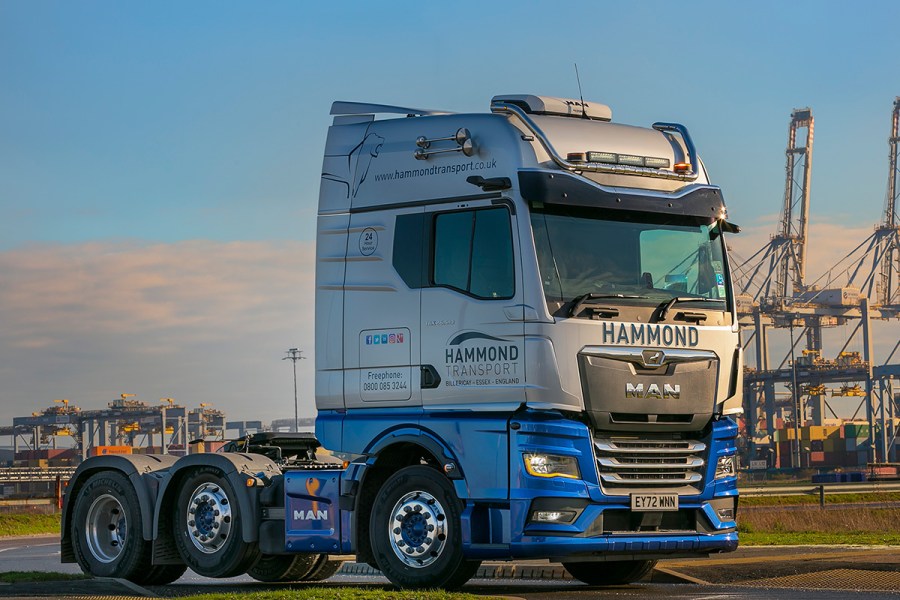TRUCKING is the first UK journal to get behind the wheel of an MAN fitted with its Optiview digital cameras… here’s our view. By Pip Dunn
MAN announced its mirror-replacing digital cameras in the summer of 2021, but with the world still a little uneasy at the time, there was no formal launch and no press drives. So understandably, it’s been a long time before I got to drive one, despite several hints about flying to Germany to try it over there!
In fact, the first TGXs with the new system had been put in use with operators, and still no press drive. So the next best thing was MAN arranging for me to get behind the wheel of one of those operators. And that haulier was loyal MAN buyer Hammond Transport, run by the incredibly amiable Terry Hammond and based in Billericay in Essex.
Technical overview
The truck I had charge of was a TGX26.510 6×2 midlift, and it’s been handed over to one of Terry’s top drivers, Scott Bryden, whom I’d met some years previously when I did a day at work feature with him.
The 26.510 is the most powerful output from MAN’s D26 12.42-litre straight six engines and along with the 26.470, the most popular MANs being sold in the UK for 44 tonne work. They are also a common sight across Europe, especially in Germany and Austria!
The truck delivers 510bhp at 1,800rpm and has a very impressive torque rating of 2,600Nm over 930-1,530rpm, ideal for today’s world. If you want, or need more power or torque, then you’ll have to go up to the 15.6-litre D38 engine, which comes with a weight penalty, not to mention being a little bit more expensive. The 26.640 is proving quite popular as a flagship truck for small fleets and owner-drivers.
The engine is coupled to MAN’s 12-speed automated Tipmatic 12.26DD gearbox with a range of ratios from 16.69-1:1 and two reverse gears. Again, 12 speeds is ‘the norm’ for the vast majority of 44 tonners these days and is ideally suited to today’s traffic conditions.
You can opt for a 24.470 or 24.510 with the small midlift axle if you prefer and want to save up to half a tonne on the tare weight and so grab a bit more payload. That said, small midlift MANs, petrol tankers aside, seem to be far fewer on the UK’s roads than, say, DAF’s FTP or Mercedes’ ‘24xx’ models.
The new MANs were launched over three years ago, just before the world melted because of Covid. They are, however, now becoming a very common sight on the roads and proving to be a hit with hauliers. And I can understand why, in fact this truck has changed my perception of the brand immeasurably.
While the cab is still the same shell as the TG-A, which appeared way back in 2001, inside MAN has done a truly fantastic job in upping the interior quality and using the massive internal space to better effect for the driver. It is one of the best cabs on the market for long-haul operations.
I have said before the new MANs demonstrate Scania quality in an MAN shell, and given the two marques are part of the same Traton family, then perhaps the Swedes have been injecting a bit of added flair into their German siblings?
The truck I drove had the biggest GX cab, the highest of the two high-roof sleeper options. The alternative is the GM, which also has a high roof and affords enough headroom to stand up. The GN is the full-width flat roof sleeper. There are three narrow cab options as well, FM for high roof, FN for the basic single bunk sleeper and the NN which is the day cab, although in typical MAN fashion, that has extra room behind the seats.
The GX cab is truly huge inside and MAN uses that space well. Gone are the days when it incorporated irritating little ‘features’ which really hindered the best use of the space and annoyed drivers and press testers alike. In fairness, MAN has been improving its cabs inside steadily over the last six years, but now it truly has a cab geared that is up for all applications, but especially long haul.

The cameras
I think this is the third time I’ve driven a 26.510 in earnest on test, and I have always found them to be decent trucks, responsive and fun to drive. The key feature though, of course, was the new Optiview so you’ll understand if I concentrate on that in the main.
I’ve been a fan of digital cameras replacing mirrors ever since MAN’s ‘arch rival’ Mercedes launched its MirrorCam in 2018 and brought it to market the following year. Since then, DAF has produced its Digital Vision Systems, which I’ve experienced on XD and XG models, while Merc’s second version of its MirrorCam is also now on the market, and again, I’ve driven that. I’ve even had the briefest drive of Scania’s ‘work in progress’ digital mirrors, and I see Iveco is now, finally, testing its systems. Just Renault and Volvo to catch up then!
And I’ve driven many mirrorless trucks on day-to-day work as well, where you get so much more of a feel for them than you do on a three-hour test drive. I’ve also driven them in all weather conditions – in bright sunshine, in the dark, in the rain and in the rain and dark together.
And yes, I’m a convert, and I’m not afraid to say so. Of course, they are modern, new technology – they couldgo wrong, so they will never be 100% perfect. But I still feel the pros far, far outweigh the cons, most of which are ‘what might happen’ rather than what does happen.
The first thing you notice about the MAN set-up is the cameras themselves seem much more durable. The mountings they are in are very sturdy, yet they will still move when forced, so meaning they will ‘bend’ in if they are clipped or hit, so they are very unlikely to break or smash. The camera arm also moves forward or inwards so again, there is limited scope for damage.
Then there are the inner screens on the A-pillars. These are bigger than other offerings, they are 15in tablet style, yet they don’t seem any bigger – it’s subtle change, but you do benefit from it.
Merc has yet to change its door and cyclops mirrors to cameras – I’m not sure why, as it does look rather pointless. DAF has its fantastic cornerview camera but it too can have that left off and traditional mirrors fitted to give it the Merc set up of cameras for the side and mirrors for the front and kerb. The DAF has a separate screen for the cornerview which I like.
For MAN, all the images from side ‘mirrors’ are on two screens, one left, one right, but the cyclops camera and kerbside camera images come up on a screen in between the seats by the infotainment system. This might be a little confusing for the driver at first but Scott told me he soon got used to it.
Scott’s opinions are invaluable – he’s a convert. Like many – such as the Healey DAF driver we spoke to earlier in this issue) – there is an initial scepticism, maybe born out of ill-informed chit chat on social media, but I am finding many drivers are telling me that their initial scepticism is soon brushed away and now they have digital cameras, they are happy and ‘wouldn’t like to go back’ to mirrors over cameras.
On the MAN the images are crystal clear, the screen alters as speed increases to give you the optimum view at any time. The screens have overlays which are lines on the mirrors which tell the driver where the back of their trailer is and so when it’s safe to pull in after overtaking. Like DAF and Merc – once you understand them and get used to them, the overlays are a superb tool.
As well as the new cameras, the MAN had the new dash set up which Scott loves, and I have to agree with him. The selector wheel arrangement works quite well; again, it’s one of those things you need some time to get used to. I have yet to get that level of competency as I drive these trucks so infrequently, but Scott is again, a fan. He says it’s easy to use, and very flexible and once you know your way around it, it’s a dream.
That’s an interesting factor on any new truck – you simply have to take time to get to know how to get the best out of them. These vehicles are tech- and gadget-heavy these days, and the only drivers who won’t like that are those who don’t have a handover, don’t listen to what the dealer is telling them and then don’t take the time out to have a play around to get the best out of the features.
Like most new trucks, the infotainment system links to a smartphone so you can play Spotify, podcasts or whatever so with a bit of advance planning, you can tailor your listening for the day to exactly what you want. No more missing your favourite radio shows or football commentaries!
The truck has plenty of USB, 12V and 24V sockets – it even had the traditional cigarette lighter socket. The dash is very good and easy to use, and again, you can set it up how you want it.
The wipers, washers, indicators and gear selector are all on the two stalks while the cruise control buttons are on the steering wheel. Another great feature of these new MANs are the buttons in the lower door so you can, for example, flick your hazards on while on the ground without the need to climb back into the cab. I do like little attention to details feature’s like this which make the driver’s job just that fractionally bit easier.
Another nice feature is being able to pre-heat the cab before starting your shift, so you get into a nice warm truck at 04:00 on a freezing February morning. Again, it’s things like this drivers will appreciate. The doors also open very wide making access – via three steps – very easy.
The spec, and quality inside the cab, is amazing, and – obviously, depending on the spec you go for – gone are the days when an MAN is a ‘boring gaffer’s motor’. It can be a thing of beauty. And any driver, even the most ardent of V8 aficionados, should like this cab and – whether they admit it publicly or not – really appreciate it. The seat position for the driver is superb, and it’s very comfortable.
The steering wheel can now be moved out of the way totally, and can rest flat to make entry and exit so much easier. There is also a sturdy pull-out flip table on the passenger side for a laptop or eating.
The storage across the cab is superb, with lots of pockets for stashing the smaller things plus plenty of under-bunk and above windscreen storage. There are four cup holders and even two in the doors (I do like trucks to have good cup holders!) There are two cavernous external side lockers as well. Scott’s truck had two bunks, but the top one can be deleted off the spec, great if you want room for more lockers of just prefer a more open space in your cab.
According to Scott, the bunk is very comfortable, and the curtains are great and block out the light and have splits to allow the mirror screens to be visible even when they are closed. These are easy to turn on and off to check around your truck when you are parked.
There are bright reading lamps at both ends of the bunk and a central control panel for lights and heaters.
Inside, the cab is massive, and there is plenty of space well used. Cross-cab moving about is easy, and while it is not a truly flat floor, it isn’t far off it.

On the road
This was more of a driver experience than a fully-fledged road test. And as it was the digital cameras that I was most interested in, I won’t go into too much detail into how the 26.510 performed, which is just as well as the trailer was unloaded, although it was heavy trailer, so the gross weight was touching 20 tonnes anyway.
The MAN handles superbly, and I took it on a good mix of roads. The local roads around the yard are tight rural single carriageway roads with limited room for manoeuvre of a six-axle artic, and the MAN handles like a dream. Then I took it onto a dual carriageway and down on to the M25 for a couple of junctions before stopping at Thurrock services for coffee.
The view from the cameras is excellent, and at no point did I hanker for traditional wing mirrors; these are so much better.
There were no rattles to be heard while on the road, nor any draughts; the build quality is top-notch. The all-round vision is also very good and the truck accelerated very well, and the engine brake was also impressive.
Conclusions
I really used to be quite ambivalent towards MANs, but the new models have not only opened my eyes up to the brand like never before, I get the impression they have had the same effect on many drivers and operators alike. I have seen these new MANs in the colours of operators who were implacable fans of Swedish and Dutch trucks.
They remain a very attractive package offering a new level of quality and a decent price. Hauliers like Terry Hammond already knew that, it’s others who are now playing catch up.
While the cab shell might be 23 years old now, in truth it’s excellent inside, and as I’ve often said, the age of the cab shell is largely irrelevant – it’s what is done to the inside that counts. And here MAN has a winner.
The main point of this test was to assess the Optiview, and I came away impressed. The images are clear and crisp, the screens are the right size and well positioned and the all-important rear view is excellent. I think I’d prefer the corner camera to have its own screen on the A-pillar like the DAF rather than in the middle, but I only drove with it for a couple of hours. The regular driver had no issues. Maybe it’s just a case of me not being familiar enough with it.
But overall, I love it. It is better than its German rival, and while I’d say DAF’s DVS just squeaks ahead of Optiview, it is only just and by the finest of margins. If I’m honest, I’m happy with all three systems and MAN’s is excellent.
Overall, this is a top notch truck in all aspects, I really like it. And you should too.
We like
- Cavernous cab
- Optiview digital mirrors
- Enhanced features for driver
- Low internal noise
- Comfortable droving position
We don’t Like
- very little of note!
Specifications
MAN 26.510 6×2 Optiview
- Design GCW: 44,000 kg
- Chassis: 3,900mm wheelbase
- Front axle: 8,000kg capacity.
- Rear axle: 11,500kg (midlift) 7,500kg (mid lift).
- Gearbox: ZF Tipmatic 12.26DD
- Engine: D2676 12.4-litre 6-cylinder in line, Euro 6e
- Max power: 510bhp @ 1,800 rpm
- Max torque: 2,600Nm @ 930-1,530rpm
- Cab: GX High roof sleeper






